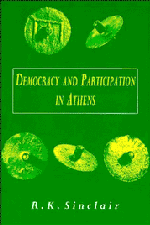Book contents
- Frontmatter
- Contents
- Preface
- Maps
- 1 The Athenian polis and the evolution of democracy
- 2 The privileges and the opportunities of the citizen
- 3 The responsibilities of the citizen
- 4 The sovereignty of the Demos, officials and the Council
- 5 Citizens and participation
- 6 The hazards of leadership
- 7 The rewards of leadership
- 8 The critics of Athenian democracy
- Appendix 1 The population of Athens
- Appendix 2 ‘Working days’
- Appendix 3 Notes on three constitutional matters
- Bibliography
- Index
Appendix 1 - The population of Athens
Published online by Cambridge University Press: 01 June 2011
- Frontmatter
- Contents
- Preface
- Maps
- 1 The Athenian polis and the evolution of democracy
- 2 The privileges and the opportunities of the citizen
- 3 The responsibilities of the citizen
- 4 The sovereignty of the Demos, officials and the Council
- 5 Citizens and participation
- 6 The hazards of leadership
- 7 The rewards of leadership
- 8 The critics of Athenian democracy
- Appendix 1 The population of Athens
- Appendix 2 ‘Working days’
- Appendix 3 Notes on three constitutional matters
- Bibliography
- Index
Summary
(A) On the vexed question of the population of Athens, see the fundamental studies of Beloch (1886 and (1923) 386–418) and Gomme. For the fifth century, see Thuc. 2.13.6–8 (and HCT) (for 431) and other evidence examined by Gomme 1–35 and Gomme (1959) 61–8, Jones 161–80, Patterson (1981) 40–81, Strauss (1979) 72–118, Whitehead (1977) 148–9, Jameson (1978) 141, Duncan-Jones (1980) 101–9, Hansen (1981) 19–32, Garnsey (1985) 62–75. For convenient tabulations of estimates of the total population and of the citizen, metic and slave components at different times from c. 480 to 313, see Gomme 26, 29, Ehrenberg (1969) 31 and Ruschenbusch (1979A) 146.
(B) The rate of population growth has been much debated. Aristotle (Pol. 1265a38–65b17) seems to indicate some increase in citizen populations in Greek cities, for he represents Plato's failure (in the Laws) to control the birth rate as based on the assumption of a sufficiently stationary population, ‘because that is thought to be the case now in the poleis’. Aristotle, however, appears to believe that in fact there was some population growth both in the mid-fourth century and earlier – sufficient to require the attention of lawgivers. Throughout the period from the mid-fifth century to 322, a natural growth of not less than ½% in the Athenian citizen population may be suggested. Before 451, when Perikles' restrictive law (see ch. 2.1) made the citizen body a ‘closed population’, the rate may have been somewhat higher.
- Type
- Chapter
- Information
- Democracy and Participation in Athens , pp. 223 - 224Publisher: Cambridge University PressPrint publication year: 1988

